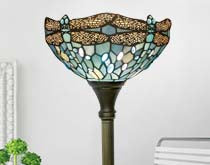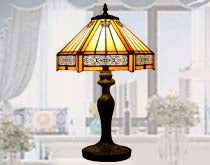Common Problems to Avoid with Tiffany Wall Lamp
Looking to add a Tiffany style wall lamp to your home? It is well known that Tiffany style lamp do not just provide light, its shape and collision with light is one of their main features.
However, when installing a Tiffany wall lamp you have to pay attention to the issue of wiring and the choice of location, as well as the use of bulb wattage and cleaning the light. In the following content, we will expand in detail the problems to avoid with Tiffany wall lamps.
Related reading: Why are Tiffany lamps so valuable?

Features of Tiffany wall lamps
Tiffany wall sconces are still made of stained glass and intricate and characteristic patterns on top of the lampshade. Wall sconces are usually used in the center or a little higher on the wall, and are equipped with easy-to-operate zipper or knob switches. Depending on the type of Tiffany style lamp, Tiffany wall sconces will also be available:
- Rose style
- Dragonfly style
- Hummingbird pattern
- Geometric
- and other such common themed styles.
The Tiffany wall lamp can be illuminated up or down, depending mainly on your preference and usage. You can place it in long hallways, outdoor walls, corners of staircases, and more. If you like you can also install it on your wall near your bedside to act as a table lamp.
Tiffany wall lamps will create a more classic, mysterious, and beautiful atmosphere, and you don't want to install it behind a wall and keep repositioning it later on due to various issues. So keep checking below for things to look out for.
Related reading: The process of customizing Tiffany wall lamps
Installation Problems
Improper fixings
It is vital to ensure that your Tiffany wall light is installed safely and securely. Choose the right fixings, such as expansion screws or wall anchors, to ensure that the fixture will not fall off due to weight or vibration. It is best to consult a professional or read the installation instructions carefully before installing.
Wiring issues
Damaged or exposed wiring not only affects the function of the fixture but can also pose a safety hazard. Ensure that wires are not cut or damaged during installation and protect them with appropriate wire clips or conduit.
Location Selection
Choosing the right wall location is critical to the long-term use of your Tiffany wall sconce. Avoid installing the fixture in direct sunlight, as prolonged exposure to UV rays may cause the stained glass to fade. It is also important to avoid installing the fixture in a place where the temperature fluctuates, such as near heating or air conditioning vents, to prevent the glass from breaking due to temperature differences.

Light and Power Problems
Using inappropriate bulbs
Choosing the right bulb is critical to ensuring the long life and optimal performance of your Tiffany wall sconces. Using bulbs that are too high or too low wattage may result in excessive heat or insufficient light. It is recommended that you read the instructions for your fixture carefully and select the recommended wattage and type of bulb.
Tiffany lamps generally use LED lights as their main light source. LED lights offer many advantages over traditional incandescent or CFLs. First, LED lights have a longer lifespan, lasting tens of thousands of hours, greatly reducing the frequency of bulb replacement.
LED lights save a lot of electricity than traditional light bulbs, so using LED lights can help users save a lot of money on their electricity bills. Moreover, using LED lights is also good for the environment because it reduces carbon emissions.
Current issue
Voltage fluctuations can cause damage to Tiffany wall sconces, especially for those fixtures with delicate electronic components. Make sure your home or commercial space has a stable power supply. If your area experiences frequent voltage fluctuations, consider using a voltage regulator to protect your fixtures.

Maintenance and cleaning issues
Improper cleaning methods
The glass and metal parts of the Tiffany Wall Sconce require special care. Using overly strong cleaners or hard cleaning tools may scratch or damage the fixture. It is recommended that you use a soft fabric and mild detergent and gently wipe the fixture to maintain its shine.
Neglecting Regular Inspections
To ensure the safety and functionality of your Tiffany wall sconces, it is recommended that you regularly inspect components such as wires, switches, and bulbs. This will not only identify and solve potential problems in time but also extend the life of the fixture.
FAQs
Are wall sconces outdated?
Wall sconces have a rich history, being among the first types of light fixtures ever used. However, their longevity in design doesn't render them old-fashioned. Their versatility ensures they remain a staple in modern home decor. Whether you're aiming for a contemporary or classic look, there's a wall sconce out there that's perfect for your space.
Should wall sconces point up or down?
The direction of your wall sconce depends on the lighting effect you desire. For illuminating larger rooms, sconces that face upwards can help disperse light more broadly. On the other hand, for more intimate or smaller spaces, downward-facing sconces might be more appropriate. Always consider the room's primary function when making your choice.
What's the ideal spacing for wall sconces?
A good rule of thumb is to position wall sconces between 66 to 72 inches from the floor, adjusting based on ceiling height. For hallways or extended staircases, aim to maintain a consistent 6-foot gap between each sconce. This ensures even lighting throughout, eliminating any unsightly dark spots.
Related reading: Quality Assessment Criteria for Tiffany Wall Lamps
Conclusion
Tiffany wall sconces, with their unique design and superb craftsmanship, have become the highlight of many homes and commercial spaces. However, in order to ensure that these beautiful fixtures maintain their original luster and functionality for a long time, users need to provide them with proper maintenance and attention.
From installation to daily use, there can be potential problems at every turn. However, many common problems can be avoided if we know in advance and take preventive measures.























